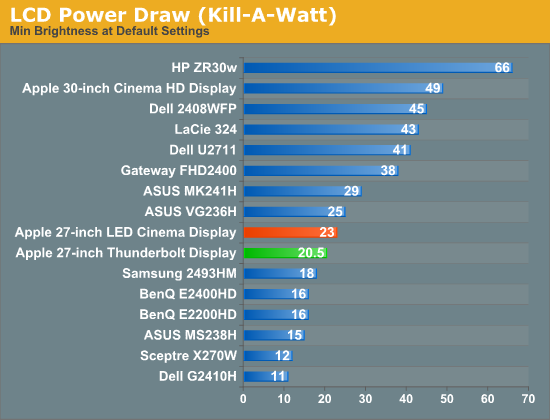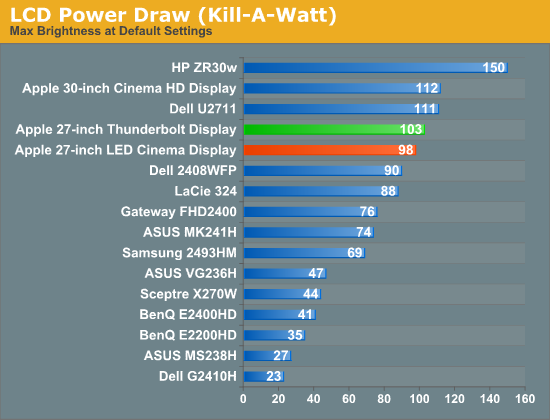The Apple Thunderbolt Display Review
by Anand Lal Shimpi on September 23, 2011 2:56 AM EST- Posted in
- Displays
- Mac
- Apple
- Thunderbolt
- Thunderbolt Display
Power Consumption
Unsurprisingly, power consumption hasn't changed much in the past year. The Thunderbolt Display draws a bit less at its dimmest setting (likely just panel efficiency variance) and draws a bit more at max brightness:


While powering a 15-inch MacBook Pro and reading data from an attached Pegasus R6 (copying to a local SSD at around 200MB/s) I measured total power consumption for the display (max brightness) at 179.6W. That number could go up if the battery in the MBP was near empty and thus being charged at a higher rate.










275 Comments
View All Comments
Boopop - Friday, September 23, 2011 - link
OK, so my Dell 2408WFP isn't as big, but in most if not all the tests it outperforms this new monitor. If I was a graphic designer (which I'm not!), even if I had a MBA I reckon I'd stick with a higher quality monitor, and put up with the extra cables.On the other hand, if I was the average Joe Bloggs with a MBA, this makes a great monitor for that specific laptop. I like where Apple are going with this, it's just a shame about the lack of many USB ports, and the average screen quality.
IceDread - Friday, September 23, 2011 - link
Normally when you test a display you also test the input lag which I find very important. I could not find info about input lag in this review.tipoo - Friday, September 23, 2011 - link
Not really as important to the target demographic, I think. Most people who get these will be using them for professional tools, so things like colour accuracy are more important than reaction time. If someone is buying one of these and a mac to game on, they've made a pretty bad error, lol.jecs - Friday, September 23, 2011 - link
You have the general idea right.For professionals not demanding the highest color accuracy for print or for broadcast production yes, the Apple monitor is a good choice. That is professionals who work on content creation like internet video, corporate videos or print material among others.
Serious print houses, photographers or broadcast professionals will choose high end specialized monitors in the range of $3000+, not in the sub $1000.
JasperJanssen - Saturday, September 24, 2011 - link
But they will generally only choose that type of monitor for *one* display, where the guy sits who does final colour correction on the output -- not for all the content creation people. (fair enough, if you're large enough that's multiple people, but it's never going to be the majority of your staff).Anand Lal Shimpi - Friday, September 23, 2011 - link
We normally test input lag by driving a CRT in parallel with the display being evaluated. I didn't have a good way of doing that with a Thunderbolt display unfortunately :-/Take care,
Anand
JasperJanssen - Saturday, September 24, 2011 - link
Well, keep it on the list for when the Mac pro comes out, which will hopefully have a videocard with multiple thunderbolt outputs :)Come to think of it -- new iMac with dual thunderbolt out and one of them through a VGA dongle? Hmno. Those are active dongles, which mess up results.
Two PCs, using NTP or something similar to sync up their internal clocks maximally, and one driving a VGA CRT with the other driving the thunderbolt display, each displaying very precisely the current system time in a large font, plus the usual fast shutter speed photography. Your accuracy would depend on the NTP-or-similar protocol. I wonder if you can get close enough with that, over a crossover Gigabit ethernet kept free of other traffic.
If you do get something like that running, you can also compare input lag between:
- Display port driving Displayport display
- Thunderbolt port driving Displayport display
- Thunderbolt port driving Thunderbolt display
-Thunderbolt port driving thunderbolt display switched through another TB device or display (add to the chain as possible)
And even whether displayport mac versus thunderbolt macs are different in this respect when running over the various dongles.
I would expect a Thunderbolt port running in Displayport mode to be very slightly slower than a real displayport, would be interesting to see if that is the case, and how it compares to a TB port in TB mode, and whether other devices on the chain affect it.
JasperJanssen - Saturday, September 24, 2011 - link
"NTP v4 with kernel mods to support it, is capable of much better than 1ms accuracy, possibly as good as 1ns. According to his article, NTP v3 is accurate to 1-2ms in a LAN and 10s of ms in WAN nets. "Well, since what you need is ms range, I guess this could actually work.
sheh - Tuesday, September 27, 2011 - link
I was curious about that too. Regardless of who the target audience of the monitor is, it's a new technology so I'm curious about its performance vs. DP/DVI/VGA. But could be difficult to tell apart from the panel's logic own latency, at least until there are more TB displays.MrJim - Friday, September 23, 2011 - link
The Youtube-video in this article, http://www.youtube.com/watch?v=LtAgkIE42jc&fea... , is private. Hard to see then :)